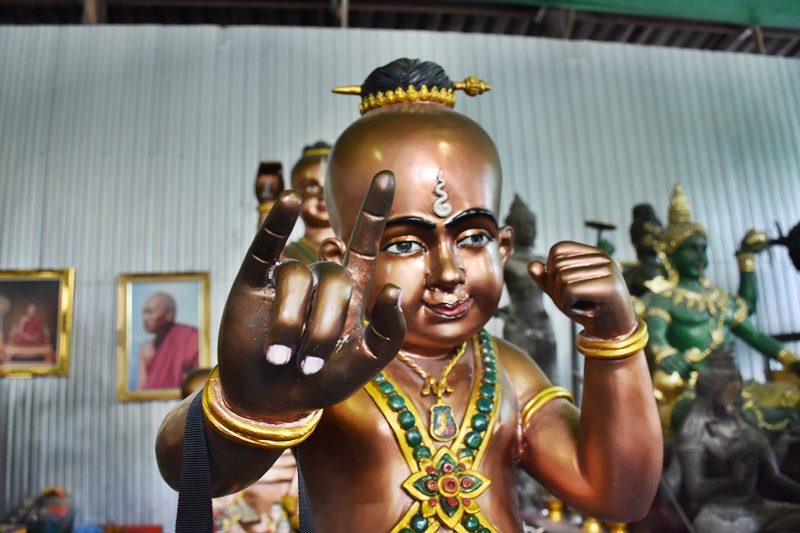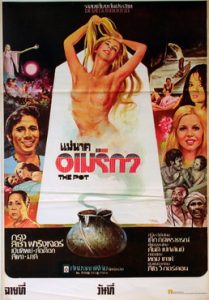
Later on in “Shutter” (2004), it reveals that the spirit is Tun’s ex, Natre. Natre’s shadows in the photos led Jane to a set of films hidden behind a bookcase, where she discoverd what Natre was trying to tell her all along: Tun was involved in a gang rape of Natre that drove her to suicide.
The film wasn’t only a common favorite for many fans of ghost movies (nang phi), it also exemplifies how Thai ghosts change their haunting habits and abodes throughout the ages, while retaining some of the elements that made them so scary for millions of Thais in the first place.
“Shutter is a perfect example of how Thai ghosts can be described, at least in films,” Pilan Poonyaprapha, who teaches film studies at Srinakharinwirot University, said in interviews. “Unlike zombies or demonic entities seen in Western movies, most Thai ghosts don’t haunt people randomly.”
The film professor and his advisor, Saminee Ratanayongpiroj, spent almost two years watching over 200 Thai horror titles, from black and white classics to modern blockbusters, to sift out the common characteristics of Thai ghosts in silver screen.
They discovered that these ghosts did more than making the audience shiver with spooky goosebumps. They also reflect broader truths in Thai society, serving as a commentary of the very real dangers haunting the society of the living, especially traditionally repressed groups of people like women.
“I think these horror films are trying to show us that humans are scarier than ghosts,” Pilan said. “Many people who become ghosts were oppressed while they were alive. That’s why ghosts explode in their malice, since there are no social or physical limits in the afterlife.”
Spiritual Urbanization
Based on the plethora of films local folk tales, Thai ghosts usually go about their business of haunting at about 2am to 3am. Pilan believes it is because it’s a time when people are drowsy and their spiritual wavelengths are compatible to ghosts.
He also noticed that Thai ghosts, especially those depicted as restless souls, are generally in their young adulthood, as they have not lived their entire lifespan. Elder and child ghosts do exist, but they tend to be worshipped as benevolent spirits like san phra phum spirit houses or kuman thong tutelary voodoo boys.

“Similar to when they are alive, elder ghosts are respected due to their seniority. People believe that elder souls rest in peace, so they are treated as guardians,” Pilan said. “Child souls normally possess objects because they are too weak to manifest themselves. They are also benign since they are still pure and innocent.”
Traditional ghost stories portray ghosts like krasue (a woman’s head with internal organs hanging down from the neck) and phi pop (flesh-eating ghost) as creatures that roam the countryside and woodlands at night.
But as Thai society moved to urban settings, the spiritual world also found its way into new spaces. In contemporary Thai films, ghosts can be found anywhere, from an airplane cabin to inside text messages and no longer are they afraid of light.
“Filmmakers have to adapt to the changing way of life. It doesn’t make sense for the main character to run into the middle of a graveyard to encounter ghosts anymore,” Pilan said. “However, the main essence of Thai ghosts remain – they are still attached to the places they took their last breath.”
Another evolution of Thai ghosts is their anatomy. They appear to show themselves less, as contemporary films tend to depict ghosts as invisible for most of the time. And when they do show up, they would be either in a pale body or some sort of floating, intangible entity.
“You can’t chop off their heads like in Western movies. You can’t touch or see them,” Pilan added.
More Than Just Scares?
Although ghosts have migrated from forests to Bangkokian condos and chat rooms, there’s one constant among the vengeful spirits – they’re almost always women.
This seems to be one of the unbroken links with traditional ghost stories, which also heavily feature female entities, from krasue and Mae Nak to the tree spirits of nang takien and nang tani.
“Anyone can become a ghost, but it appears that female ghosts are much more common,” Pilan said.
The lecturer said it might be because in a Thai woman’s life, she’s more likely to be oppressed, and therefore to avenge her injustices in the afterlife.
“Souls become ghosts because they are restless. They still have some unfinished business to do or some revenge to commit,” Pilan said. “Thai ghosts are representations of a person’s needs. They’re not there to challenge God or religion.”

Due to the state of misogyny in Thai society, many ghost films are actually at heart the story of a woman wronged and abused – cheated on, raped, or otherwise suffering in their role as wife or mother, such as the popular story of Mae Nak who died in childbirth while waiting for her husband at war.
“In Shutter, Natre becomes haunted because she committed suicide after being raped. That’s why her soul is still hanging around trying to warn Jane,” Pilan said. “Natre also unleashed her rage by killing everyone involved in the gang rape. There her unfinished business is resolved.”
The ghostly revenge on people who wronged them also shows the influence of Buddhism, the country’s dominant religion. Sometimes they straight up tell a story of justice served, bad guys meeting bad endings in life, karma style. On other occasions they simply show the audience the suffering female characters had to endure.
However, despite these social and gender undertones, it’s important to bear in mind that Thai ghosts films are usually scare-filled love triangles, rather than incisive commentaries on the society we live in.
“Most of them are romantic tragedies, or about a dispute between a small group of people,” Pilan said. “I haven’t seen one that really challenges a broader issue in society yet.”
By Tappanai Boonbandit
